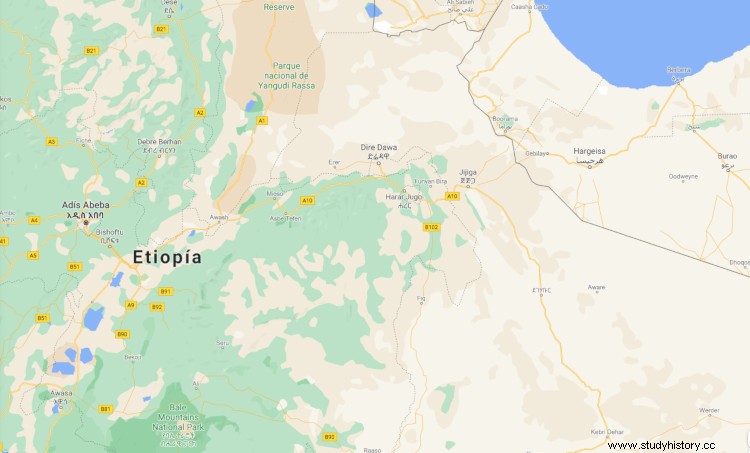Archeology brought to light in mid-2017 an ancient lost, buried and forgotten city whose cyclopean architectural characteristics have led its discoverers to baptize it unofficially, half seriously, half jokingly, city of the giants. Something that is also endorsed by some local legends about the extraordinary size of its inhabitants.
Many archaic myths are common to almost all cultures, no matter how remote they are geographically, because they are based on basic concepts (the Good-Evil opposition, a flood as the origin of the world, etc). One of the most widespread is that of the existence of giants, which can be found on various continents and civilizations, from the Sumerian and its description of the hero Gilgamesh to the Nordic legends in which the jotuns they face the gods, going through the Greek cyclops, the nephilim Hebrews, the nosjthelj of the Tehuelche Indians, etc.
The fact is that a team from the University of Exeter, United Kingdom, has been working in Haarla, a place in eastern Ethiopia located about one hundred and twenty kilometers from the Red Sea and three hundred from the capital, Addis Ababa. Leading the work is Timothy Insoll, a specialist in the archeology of religions and rituals, an expert in the history of Islam in Africa as well as in other cults on the continent. It is not the first time that he visits Ethiopia because he has been excavating in Mursi before.

Born in 1967, Insoll studied at the University of Sheffield and received his Ph.D. from St John's College, Cambridge, where he entered as a research fellow before becoming a professor in Manchester, an honorary curator of the Ghana Board of Museums and an Honorary Academic Curator of African Archaeology. in the Manchester Museum. Member of the Society of Antiquaries and the Royal Asiatic Society , is part of the editorial boards of several specialized magazines and has directed archaeological excavation campaigns in several African sites in various countries:Mali, Eritrea, Uganda, Ghana... He has also worked in corners of other continents such as Bahrain or India.
Ethiopia is of special interest because, although the popular image of this country is little more than a desert, the truth is that it is a stereotype (there are also savannah, jungle and high mountains) and its history, in addition to being interesting , still keeps many monumental secrets of great value. A good example of this is this recently discovered city that, according to experts, is proof that Ethiopia was not an isolated place and had intense commercial relations with the Persian Gulf, Egypt and India between the 10th and 15th centuries.
One of the centers of this trade would be the city revealed, which has also provided interesting evidence of it in the form of numerous objects and jewels:fragments of glass vessels, ceramics, necklace beads, tortoiseshells, carnelians, semi-precious stones, coins medieval Egyptian bronze and silver… The most surprising thing is that they have the most varied origins:there are from neighboring Egypt and Yemen, on the other side of the Red Sea; but also from Madagascar, the Maldives and even India and China. All this will be exhibited in a future local museum that should contribute to economically revitalizing the region.
Likewise, the discovery of a 12th-century mosque with a style similar to those found in Somalia and Tanzania has caused astonishment, demonstrating the more than probable contacts and influences between the different African Islamic communities. Being one of the oldest Muslim enclaves in Africa, Haraar could become a key place to find out more about the first steps of Islam in the black continent. It is believed that this faith spread through African lands after the death of Mohammed in the middle of the 7th century; however, there are theories that suggest that he sent disciples to Abyssinia in the same century. The issue is important because today Ethiopia is a predominantly Christian country, with only a third of its population Muslim.

Now, if all this is already sensational news in itself, it takes on even more fascinating overtones when it is learned that the British team also exhumed the remains of three hundred inhabitants who had been buried in graves with Islamic rite tombstones; they are now proceeding to chemically analyze said remains to determine their diet. The jug of cold water is for those who expected the skeletons to correspond to giants, those who, according to local myth, had to be people of extraordinary height and strength; the bones correspond to normal people.
This myth was based on the large blocks of stone used to build the buildings and walls, but also on the strange pieces that the current neighbors found from time to time when tilling their fields and that thanks to archeology we know that it was, in effect, , of exotic ornaments and coins, coming from the East, which would indicate that not only its African inhabitants lived in the city but that there was probably a fairly important foreign community due to the commercial importance of the site. And it is already known that foreigners are always mysterious, raising gossip and misgivings.
Despite the fact that the campaign has been going on for two years, it is very difficult to make people forget the myths that take root in the popular mentality. As Timothy Insoll himself says about the alleged giants in the city:"Obviously we've refuted that but I'm not sure they fully believe us. Some say that the bodies we've discovered are the children of giants!"
